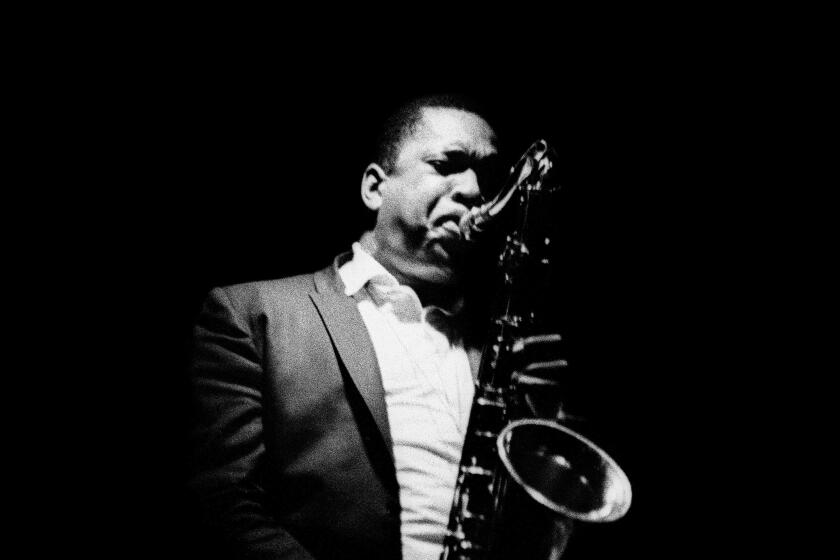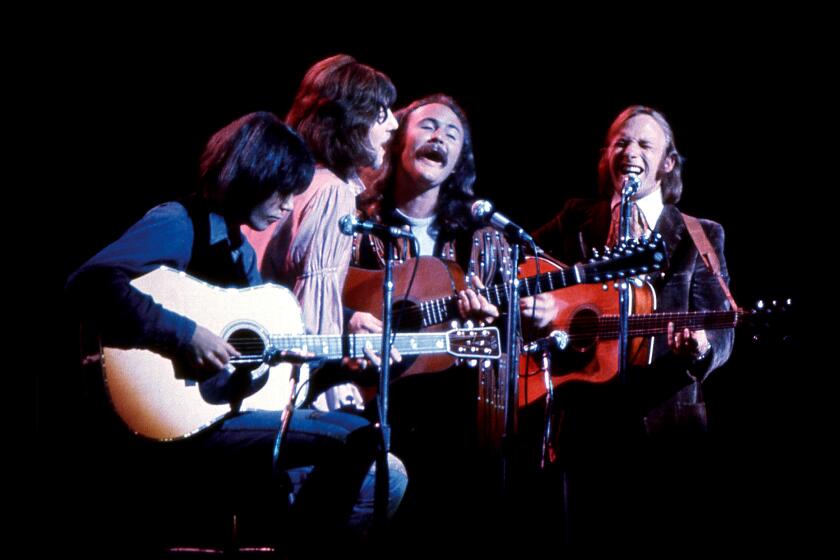NEW AGE IS COMING OF AGE, BUT SOFTLY
- Share via
SAN DIEGO — English art-rocker Eddie Jobson extols it as “the sound track for the movie of the mind.” Others derisively refer to it as “audio Valium” or “yuppie elevator music.”
It is called New Age music and consists mostly of soft, breezy instrumentals with meditative titles like “Deep Breakfast” and “In Search of the Turtle’s Navel.” It has made overnight stars of studio hermits like Mannheim Steamroller and Kitaro.
And, like it or not, it has already taken over two San Diego radio stations, drowning their programming in a hot tub of white Zinfandel and offering listeners a soothing alternative to screaming Top 40 deejays and pulsating techno-pop dance hits.
“It’s what our listeners want,” said Lee Mirabal, general manager of KIFM-FM (98.1), which since Aug. 31 has been programming its own “Lites Out” blend of New Age and light contemporary jazz 24 hours a day.
“Originally, we had been playing New Age and jazz only at night, with regular adult-contemporary (A/C) programming during the day,” Mirabal said.
“But our audience has been telling us in many ways that they want to hear this music all day as well, so since we took over in July of 1986, we’ve been slowly moving in that direction.”
A month after KIFM entered the New Age, KSDO-FM (102.9) dumped its 4-year-old Top 40 programming in favor of “The Wave,” a nationally syndicated format from Los Angeles that offers a mix of New Age, soft rock and light jazz.
At the same time, the station dismissed its air staff--there’s no room for deejays on The Wave--and adopted a new set of call letters, KSWV, to reflect the change, said president and general manager Chris Conway.
“For nearly five years, New Age music has accounted for 20% of all cassette and compact-disc sales around the country, yet it’s been completely ignored by radio,” Conway said.
“Radio programmers have been so caught up with traditional formats like Top 40, A/C and album-oriented rock that they sort of lost touch with their listeners.
“And already, our ad salesmen tell me that people all around the county are talking about The Wave and tuning in--people we never could have reached had we stuck with Top 40.”
Mirabal and Conway have good reason to be optimistic. Last Valentine’s Day, Los Angeles album-rock stalwart KMET-FM (94.7), after several years of declining ratings, created The Wave and switched call letters to KTWV.
Within three months, the station’s listenership had gone up a whopping 56%. Ever since, radio programmers around the country have been hitching a ride on the New Age bandwagon as fervently as they had previously jumped on the Top 40, disco and new-wave bandwagons.
At last count, more than 100 U.S. radio stations have adopted New Age formats, either KTWV’s original The Wave, now in syndication, or homespun variations like KIFM’s “Lites Out.”
None of this has gone unnoticed by the national press. A headline in Billboard magazine recently proclaimed, “New Age Is the New Rage With California Stations.” A Wall Street Journal headline observed, “New Age Music Wins Wider Following as Many People Grow Too Old for Rock.” In USA Today, radio analyst Jim Duncan was quoted as saying, “A year from now, 40% of the Top 50 markets will have the format.”
But that doesn’t mean everyone’s happy. Ron Galon, a deejay on local all-jazz station KSDS-FM (88.3), said that, by broadcasting New Age music, radio programmers “are showing more of a concern for the bottom line than for their responsibility to enlighten.”
A veteran San Diego radio observer said that, if he was in charge of KIFM or KSWV, “I’d be worried about my listeners falling asleep in their cars on their way home from work.”
KSWV’s Conway, however, feels otherwise. “I’ve been listening to it a lot, and most of it’s really pretty,” he said. “It’s instrumental music that belongs in the foreground, not in the background like elevator music.”
The primary reason why KSDO-FM became KSWV, Conway said, is that for nearly a year, the station had been waging a losing battle in the Top 40 sweepstakes, particularly since the debut last March of a new competitor, KKLQ-FM (Q-106).
“Our audience share went down from 6.6 in last fall’s Arbitron survey to 3.5,” Conway said. “Top 40 listeners are loyal to the music instead of any one station; anytime something new comes along, it cuts into your audience.
“We could have stuck this out, and eventually things would have settled down. But then this new format came along with an amazingly successful track record, and I decided that after four years, it was time to get out of Top 40.”
More to Read
The biggest entertainment stories
Get our big stories about Hollywood, film, television, music, arts, culture and more right in your inbox as soon as they publish.
You may occasionally receive promotional content from the Los Angeles Times.










